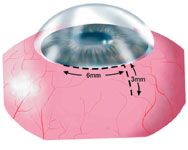Article
Scleral flap technique simplifies glaucoma device implantation
Fort Lauderdale, FL-Experience with implantation of the Ex-PRESS miniature glaucoma device (Optonol Ltd.) under a scleral flap in high-risk eyes shows that it is a simple and effective technique for controlling IOP and reduces complications encountered with subconjunctival implantation, said Trevor R. Carmichael, MD, PhD, at the annual meeting of the Association for Research in Vision and Ophthalmology.

Dr. Carmichael, professor of ophthalmology, University of the Witwatersrand, Johannesburg, South Africa, presented outcomes achieved in a two-center study performed with Elie Dahan, MD, medical director and chairman, Oxford Eye Centre, Johannesburg. Their series included 24 eyes of 23 patients; all had complicated glaucoma, and the surgical technique routinely incorporated adjunctive mitomycin-C (Mutamycin, Bristol-Myers Oncology) to reduce the risk of bleb failure.
Mean follow-up for the group was 75 weeks with 20 eyes seen at 1 year and eight eyes reaching the 2-year visit. Mean IOP was 27 mm Hg at baseline, fell sharply on day 1, but increased to about 14 mm Hg by 1 week and remained stable thereafter with minimal medication use.

"In our first 12 cases of uncomplicated primary open-angle glaucoma with no history of surgery, we encountered three bleb failures, had to remove three devices because of erosion, and had a number of problems with overfiltration leading to hypotony and flat anterior chamber," Dr. Carmichael said. "The present technique was designed to reduce those risks and seems to have been successful in achieving that goal while providing good flow control. However, further follow-up in more eyes is needed to demonstrate that this device makes filtering surgery work better and longer."
The 23 patients in the current series were about two-thirds male and had a mean age of 60 years. Sixteen had previously not had a response to glaucoma surgery, including eight of nine Caucasians. There were also eight Africans, five Indians, and one patient of mixed race. Two (9%) patients had pseudocapsular exfoliation glaucoma and the rest had primary open-angle glaucoma.

Newsletter
Don’t miss out—get Ophthalmology Times updates on the latest clinical advancements and expert interviews, straight to your inbox.




